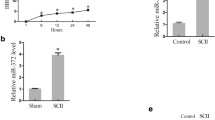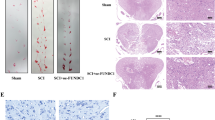Abstract
Spinal cord ischemia and reperfusion (SCIR) injury can induce autophagy, which is involved in the survival of neurons. However, whether autophagy plays a neuroprotective or a detrimental role in SCIR injury remains controversial. Angiopoietin-1 (Ang-1), an endothelial growth factor, has been shown to have neuroprotective effects. The present study aimed to explore the neuroprotective mechanisms of Ang-1 in neuronal cells in a rat model of SCIR injury in vivo. Ang-1 protein and rapamycin were injected intrathecally. Basso Beattie Bresnahan (BBB) scoring and hematoxylin and eosin staining were used to assess the degree of SCIR injury. Proteins that reflected the level of autophagy expression, such as Beclin-1 and LC3, were evaluated by western blotting. The results indicated that SCIR injury resulted in loss in lower limb motor function. Ang-1 protein inhibited the expression of Beclin-1 and LC3, which improved the BBB score and alleviated spinal cord injury. In contrast, rapamycin, an autophagy activator, caused the opposite effect. This study provides evidence that Ang-1 plays a neuroprotective role by inhibiting of autophagy expression in SCIR injury. Overall, findings could be useful for the treatment of SCIR injury.





Similar content being viewed by others
References
Kardes O, Civi S, Tufan K et al (2017) Effects of atorvastatin on experimental spinal cord ischemia–reperfusion injury in rabbits. Turk Neurosurg 27:594–602
Bruce M, Gerard L (2015) Management of severe spinal cord injury following hyperbaric exposure. Diving Hyperb Med 45:210
Cheng MM, Humphreys KA (2012) Acute effect of ghrelin on ischemia/reperfusion injury in the rat spinal cord. Int J Mol Sci 13:9864–9876
Fan J, Zhang Z, Chao X et al (2014) Ischemic preconditioning enhances autophagy but suppresses autophagic cell death in rat spinal neurons following ischemia–reperfusion. Brain Res 1562:76–86
Fang B, Li XQ, Bi B et al (2015) Dexmedetomidine attenuates blood-spinal cord barrier disruption induced by spinal cord ischemia reperfusion injury in rats. Cell Physiol Biochem Int J Exp Cell Physiol Biochem Pharmacol 36:373
Saito T, Saito S, Yamamoto H et al (2013) Neuroprotection following mild hypothermia after spinal cord ischemia in rats. J Vasc Surg 57:173–181
Fang B, Li XQ, Bao NR et al (2016) Role of autophagy in the bimodal stage after spinal cord ischemia reperfusion injury in rats. Neuroscience 328:107–116
Bischoff MS, Di LG, Griepp EB et al (2011) Spinal cord preservation in thoracoabdominal aneurysm repair. Perspect Vasc Surg Endovasc Therapy 23:214–222
Temiz C, Solmaz I, Tehli O et al (2013) The effects of splenectomy on lipid peroxidation and neuronal loss in experimental spinal cord ischemia/reperfusion injury. Turk Neurosurg 23:67
Matsui Y, Takagi H, Qu X et al (2007) Distinct roles of autophagy in the heart during ischemia and reperfusion: roles of AMP-activated protein kinase and Beclin 1 in mediating autophagy. Circ Res 100:914
Miao S, Jie L, Dai W et al (2013) Ethyl pyruvate ameliorates hepatic ischemia–reperfusion injury by inhibiting intrinsic pathway of apoptosis and autophagy. Mediat Inflamm. https://doi.org/10.1155/2013/461536
Lum JJ, Deberardinis RJ, Thompson CB (2005) Autophagy in metazoans: cell survival in the land of plenty. Nat Rev Mol Cell Biol 6:439–448
Wang ZY, Liu WG, Muharram A et al (2014) Neuroprotective effects of autophagy induced by rapamycin in rat acute spinal cord injury model. Neuroimmunomodulation 21:257–267
Kaushal GP (2012) Autophagy protects proximal tubular cells from injury and apoptosis. Kidney Int 82:1250–1253
Zhang X, Yan H, Yuan Y et al (2013) Cerebral ischemia–reperfusion-induced autophagy protects against neuronal injury by mitochondrial clearance. Autophagy 9:1321–1333
Liu B, Han D, Zhang T et al (2018) Hypoxia-induced autophagy promotes EGFR loss in specific cell contexts, which leads to cell death and enhanced radiosensitivity. Int J Biochem Cell Biol 111:12–18
Wang L, Feng D, Liu Y et al (2017) Autophagy plays a protective role in motor neuron degeneration following spinal cord ischemia/reperfusion-induced spastic paralysis. Am J Transl Res 9:4261
Xie L, Yu S, Yang K et al (2017) Hydrogen sulfide inhibits autophagic neuronal cell death by reducing oxidative stress in spinal cord ischemia reperfusion injury. Oxidative Med Cell Longev 2017:1–15
Augustin HG, Koh GY, Thurston G et al (2009) Control of vascular morphogenesis and homeostasis through the angiopoietin-Tie system. Nat Rev Mol Cell Biol 10:165–177
Onda T, Honmou O, Harada K et al (2008) Therapeutic benefits by human mesenchymal stem cells (hMSCs) and Ang-1 gene-modified hMSCs after cerebral ischemia. J Cereb Blood Flow Metab 28:329–340
Herrera JJ, Sundberg LM, Zentilin L et al (2010) Sustained expression of vascular endothelial growth factor and angiopoietin-1 improves blood-spinal cord barrier integrity and functional recovery after spinal cord injury. J Neurotrauma 27:2067
Yin J, Gong G, Liu X (2019) Angiopoietin: a novel neuroprotective/neurotrophic agent. Neuroscience 411:177–184
Valable S, Bellail A, Lesné S et al (2003) Angiopoietin-1-induced PI3-kinase activation prevents neuronal apoptosis. FASEB J 17:443–445
Zhou L, Ma B, Han X (2016) The role of autophagy in angiotensin II-induced pathological cardiac hypertrophy. J Mol Endocrinol 57:R143
Erlich S, Alexandrovich A, Shohami E et al (2007) Rapamycin is a neuroprotective treatment for traumatic brain injury. Neurobiol Dis 26:86–93
Basso DM, Beattie MS, Bresnahan JC (1995) A sensitive and reliable locomotor rating scale for open field testing in rats. J Neurotrauma 12:1
Sun JF, Yang HL, Huang YH et al (2017) CaSR and Calpain contribute to the ischemia reperfusion injury of spinal cord. Neurosci Lett 646:49–55
Bao N, Fang B, Lv H et al (2018) Upregulation of miR-199a-5p protects spinal cord against ischemia/reperfusion-induced injury via downregulation of ECE1 in rat. Cell Mol Neurobiol 38:1293–1303
Boyaci MG, Eser O, Kocogullari CU et al (2015) Neuroprotective effect of alpha-lipoic acid and methylprednisolone on the spinal cord ischemia/reperfusion injury in rabbits. Br J Neurosurg 29:46–51
Klionsky DJ, Emr SD (2000) Autophagy as a regulated pathway of cellular degradation. Science 290:1717–1721
Hara T, Nakamura K, Matsui M et al (2006) Suppression of basal autophagy in neural cells causes neurodegenerative disease in mice. Nature 441:885–889
Rami A, Langhagen A, Steiger S (2008) Focal cerebral ischemia induces upregulation of Beclin 1 and autophagy-like cell death. Neurobiol Dis 29:132–141
Park Y, Liu C, Luo T et al (2015) Chaperone-mediated autophagy after traumatic brain injury. J Neurotrauma 32:1449–1457
Fujita S, Sakurai M, Baba H et al (2015) Autophagy-mediated stress response in motor neurons after hypothermic spinal cord ischemia in rabbits. J Vasc Surg 62:1312–1319
Zhao Y, Li Z, Wang R et al (2010) Angiopoietin 1 counteracts vascular endothelial growth factor-induced blood-brain barrier permeability and alleviates ischemic injury in the early stages of transient focal cerebral ischemia in rats. Neurol Res 32:748–755
Kosacka J, Figiel M, Engele J et al (2005) Angiopoietin-1 promotes neurite outgrowth from dorsal root ganglion cells positive for Tie-2 receptor. Cell Tissue Res 320:11–19
Kosacka J, Nowicki M, Kacza J et al (2010) Adipocyte-derived angiopoietin-1 supports neurite outgrowth and synaptogenesis of sensory neurons. J Neurosci Res 83:1160–1169
Funding
Lianyungang Science and Technology Bureau provided financial support in the form of the Health and Family Planning Science and Technology Project (Grant No. 201703). The sponsor played no role in the design or conduct of this research.
Author information
Authors and Affiliations
Corresponding authors
Ethics declarations
Conflict of interest
All authors certify that they have no affiliations with or involvement in any organization or entity with any financial interest (such as honoraria; educational grants; participation in speakers' bureaus; membership, employment, consultancies, stock ownership, or other equity interest; and expert testimony or patent-licensing arrangements), or non-financial interest (such as personal or professional relationships, affiliations, knowledge or beliefs) in the subject matter or materials discussed in this manuscript.
Ethical Approval
All procedures performed in studies involving animals were in accordance with the ethical standards of the institution or practice at which the studies were conducted.
Additional information
Publisher's Note
Springer Nature remains neutral with regard to jurisdictional claims in published maps and institutional affiliations.
Rights and permissions
About this article
Cite this article
Yin, J., Yin, Z., Wang, B. et al. Angiopoietin-1 Protects Spinal Cord Ischemia and Reperfusion Injury by Inhibiting Autophagy in Rats. Neurochem Res 44, 2746–2754 (2019). https://doi.org/10.1007/s11064-019-02893-3
Received:
Revised:
Accepted:
Published:
Issue Date:
DOI: https://doi.org/10.1007/s11064-019-02893-3




